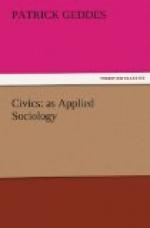B—THE HISTORIC SURVEY OF CITIES
But a city is more than a place in space, it is a drama in time. Though the claim of geography be fundamental our interest in the history of the city is supremely greater; it is obviously no mere geographic circumstances which developed one hill-fort in Judea, and another in Attica, into world centres, to this day more deeply influential and significant than are the vastest modern capitals. This very wealth of historical interests and resources, the corresponding multiplicity of specialisms, more than ever proves the need of some means by which to group and classify them. Some panoramic simplification of our ideas of history comparable to that of our geography, and if possible congruent with this, is plainly what we want. Again the answer comes through geography, though no longer in mere map or relief, but now in vertical section—in the order of strata ascending from past to present, whether we study rock-formations with the geologist, excavate more recent accumulations with the archaeologist, or interpret ruins or monuments with the historian. Though the primitive conditions we have above noted with the physiographer remain apparent, indeed usually permanent, cities have none the less their characteristic phases of historic development decipherably superposed. Thus below even the characteristically patriarchal civilisations, an earlier matriarchal order is often becoming disclosed. Our interest in exploring some stately modern or Renaissance city is constantly varied by finding some picturesque mediaeval remnant; below this some fragment of Roman ruin; below this it may be some barbarian fort or mound. Hence the fascinating interest of travel, which compels us ever to begin our survey anew. Starting with the same river-basin as before, the geographic panorama now gains a new and deeper interest. Primitive centres long forgotten start into life; pre-historic tumuli give up their dead; to the stone circles the




